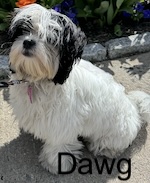Alaskan Husky(left), Siberian Husky(right); they both actively enjoy sled pulling and pulling their owner on skis.
The unregistered hybridized Alaskan Husky is preferred for dogsled racing. It is primarily used for working purposes, unlike the Siberian Husky which is used for both show and working purposes. Alaskan Huskies are carefully bred to produce the best working dogs possible. The breedings of the Alaskan Husky are planned breedings and are technically pedigreed, however they are not consider pure and are not registered by the AKC or CKC because they are sometimes crossed with other Northern and non-Northern breeds to produce the best working dogs possible. The Alaskan Husky is unlike the Siberian Husky, which is a purebred dog that is registered with the AKC and the CKC and is used as a show dog as well as a working dog.
In sled pulling races the Alaskan Huskies are usually used in the longer distance races and Siberian Huskies are often used in the shorter distance races. Sled dogs have been known to travel over 100 miles in a 24-hour period.
Appearance wise, Alaskan Huskies are usually leaner in build than Siberians with a more pronounced tuck-up. Siberians often have blue or any combination of blue and brown eyes, whereas Alaskan Huskies often have brown eyes.
Sibieran Husky
Weight: Males 45 - 60 pounds (20 - 27 kg) Females 35 - 50 pounds (16 - 22½ kg)
Alaskan Husky
Weight: Males 40 - 60 pounds (18 - 27 kg) Females 35 - 48 pounds (16 - 22 kg)
Crosses between the Alaskan Husky and the Siberian Husky are called Alaskan Amerindian Huskies. This type of Husky was started in the 1970s.
Alaskan Husky (left), Siberian Husky (right)
Alaskan Husky (left), Siberian Husky (right)
Alaskan Husky (left), Siberian Husky (right)
